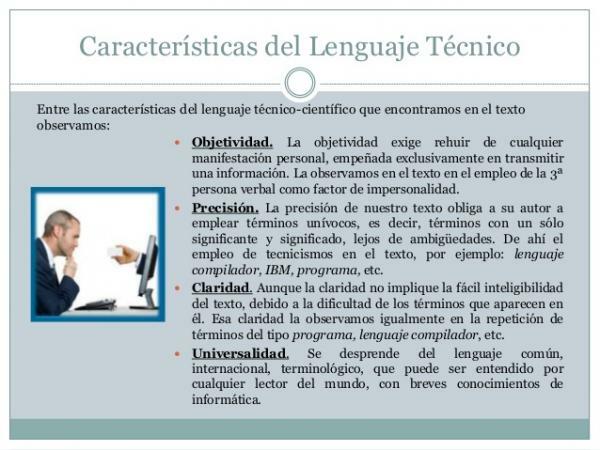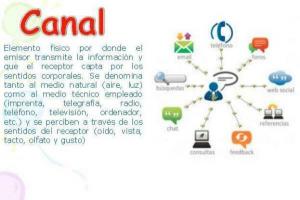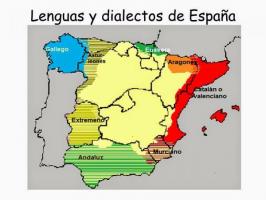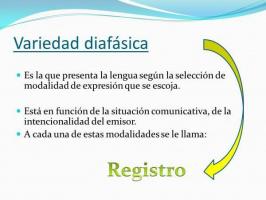Technical language: definition and examples

Image: Slideshare
When trying to read a specialized text It is very likely that we will find a specific vocabulary of that specific activity or area of knowledge that is incomprehensible to the uninitiated. This can happen if someone with no mechanical training reads a text on the subject or if someone Without computer knowledge, he reads a manual aimed at experts and it happens mainly due to the use of technical language. In this article a teacher will give a definition of technical language, its main features (some of which will differentiate it from other specific languages) and usage examples will be provided.
The language used by the speakers is different according to their social, geographical and situational circumstances. This usually distinguishes the different language varieties:
- 1. Varieties that depend on the linguistic competence of the speaker.
- 1.1. Diatopic varieties: those that are defined by the place where the speaker lives / comes from.
- 1.2. Diastratic varieties: those that are defined by the level of education and the social stratum of the speaker.
- 2. Diaphasic varieties: those that are determined by the situation in which the speaker is.
Within the diastratic varieties there are a series of linguistic subsystems that identify a sociocultural group. They are called specific languages. They are heterogeneous and unlimited, and depend, above all, on two extralinguistic factors: the sociological (since they are the hallmark of a social group) and thematic (since they serve to transmit knowledge and designate objects). There are four fundamental types:
- Slang or slang: They have a cryptic and differentiating purpose. Some examples are found in the slang of crime (snitch, sing, lumber) or in youth slang (colleague, weekend, hatch). Many of these terms are already used in the common language.
- Sector language: Used by people who carry out a certain professional activity. It has no cryptic purpose. Some would be political language, sports language or legal language.
- Scientific language: Used to transmit knowledge of different sciences and disciplines, such as biology, medicine, physics or linguistics. It has no cryptic purpose.
- Technical language: Used to convey knowledge and instructions with practical applications. There may be information technology, engineering, medicine, the legal field, etc. It has no cryptic purpose.
In this other lesson we will discover the differences between the educated, standard and popular language.

Image: Tecnologia1
This time we are going to focus on technical language, which has many similarities with scientific language, as well as with the sector. These are the main features of technical language:
- This language tends to explain yourself, that is, to have a metalinguistic function.
- Seeks to be the most precise possible.
- Seeks to maintain a terminology coherent, that is, that the meaning varies as little as possible.
- It is the result of a tacit consensus among its users, so it is a language conventional.
- Enter elements formalized such as schematics, diagrams, math symbols, and plans.
What is technical vocabulary?
Like all specific languages, its greatest differentiation in terms of the common language is found in the lexical plane. Each lexical unit of this language is called technicality. The technical vocabulary usually meets the following traits:
- It is restricted: it is incomprehensible to the uninitiated in the area.
- It is univocal: the correspondence between signifier and signified must be as univocal as possible, since great specificity is sought.
- It's universal: it should allow a relatively simple translation into any language.
- Contains numerous loans of other languages.
- It also contains numerous neologisms, necessary to refer to new objects or concepts.

Image: Slideshare
Although less abundant, in technical language we will also find some morphological and syntactic characteristics own:
- Abundant nouns and economy in the use of adjectives
- Adjectives serve a denotative, not a connotative function
- Use of verb tenses in the present
- Use of the third person and impersonal sentences
- Use, in most cases, of declarative sentences
- Tendency to linguistic economics
In the following usage examples you can see the features of the technical language mentioned:
“The basic network of the superblocks is reduced by 61% of the length of the total of roads that today are intended for through traffic. This drastic reduction does not imply a proportional decrease in the number of vehicles in circulation in order to obtain the same level of service (the same speed as the vehicles in circulation). In Barcelona, a 13% reduction in vehicles achieves a level of service similar to the current one. Therefore, the functionality and organization of the system is maintained and, as has been said, 70% of the space dedicated today to mobility is freed ”.
Salvador Rueda, The superblock, a new urban cell for the construction of a new functional and urban model of Barcelona.
“The tractor has an electricity producing plant made up of a generator (alternator), the battery and the voltage regulator; This plant provides electricity to at least three systems: heating (in indirect injection engines), starting and lighting. At present it is common for engines to be commanded by an electronic control unit that determines injection, valve tuning, etc. Besides that many have their electric fuel pumps. This makes the electrical system in the new tractors essential to have it in optimal conditions because they directly condition the operation of the tractor ”.
Ministry of Agroindustry of the Province of Buenos Aires, Agrarian Mechanics Manual.
"Not only is Spain one of the countries with the highest wind development per capita, but also the sector will continue growing, since onshore wind is consolidated as the key technology to meet the European objectives of the 2020. According to the objectives of the Renewable Energy Plan 2011-2020, installed onshore wind energy (35,000MW) by 2020 will represent 55% of the renewable energy mix and the marine will go from 0 to 750 MW ”.
SEO / Birdlife, Guidelines for evaluating the impact of wind farms on birds and bats.



